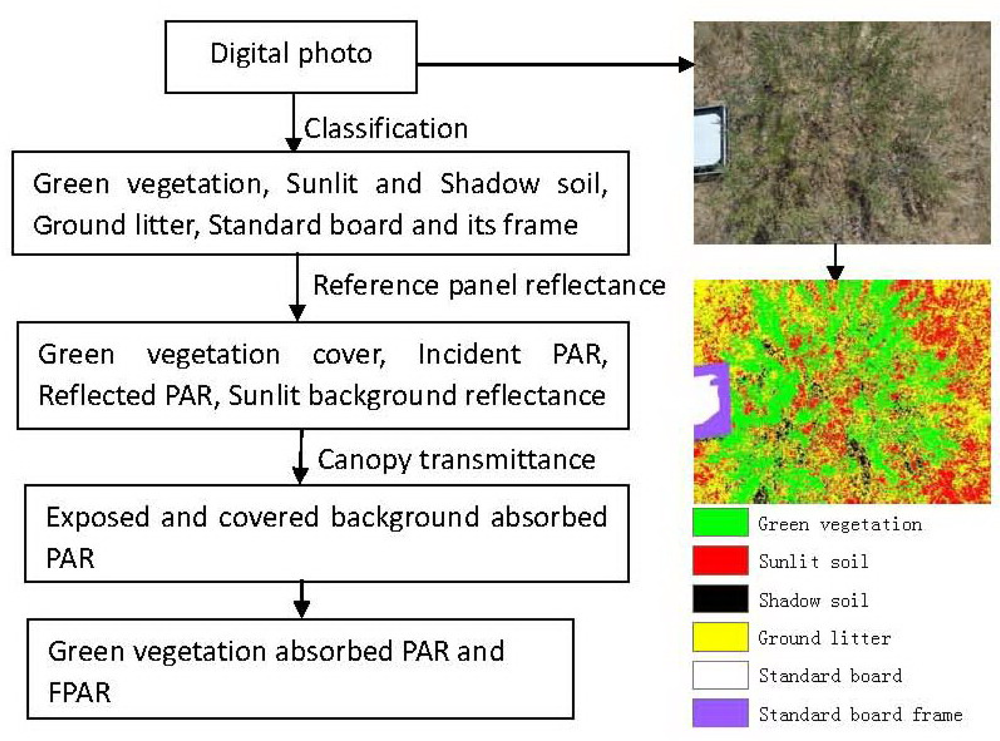A Novel in Situ FPAR Measurement Method for Low Canopy Vegetation Based on a Digital Camera and Reference Panel
Abstract
:1. Introduction
2. Method
2.1. Scene Classification
2.2. Calculation of Incident PAR and Scene-Reflected PAR
2.3. Calculation of the Background-Absorbed Radiation and FPAR
3. Field Test Experiments
4. Uncertainty of FPAR Measurement
- FPAR is defined as the fraction of PAR absorbed by vegetation in the 400–700 nm spectrum, and the digital camera has adequate bandwidth covering the spectral range of 400–700 nm [5]. However, there are some gaps and overlapping regions of RGB. Therefore, some uncertainties exist in the FPAR calculated using the average of the DN values of RGB.
- The transmitted PAR on the green vegetation-covered background was assigned by empirical values, which should vary with canopy structure, such as LAI and illumination conditions (such as sun zenith angle and ratio of diffusion light). In this study, the canopy transmittance (τ) was assumed to be a constant 0.05.
- According to Equations (1) and (2), the background absorbed PAR (PARg) is one of the necessary parameters to calculate green vegetation FPAR [4]. For low vegetation, the covered background was not exposed, and its optical reflectance was unknown. In this study, the green vegetation covered background was assumed to have the same reflectance as exposed background, and this assumption might be one of the error sources of FPAR calculation by this developed method.
- An accurate classification of the digital camera image was a prerequisite for the accurate calculation of canopy. Classification errors would affect the results significantly. The biggest challenge was to distinguish the shadowed green leaves from shadowed background. In addition, the edges of the digital photograph have an off-nadir view, which would increase the estimated fractional cover of green vegetation (fc) around the edges of the photograph.
- Digital camera exposure settings and the reference panel reflectance are two potential sources of uncertainties. In order to produce a photograph pleasing to the eye, the gamma and white balance temperature are always used in digital cameras, which cause a non-linear relationship between DN and reflectance. Photos should be taken in a raw file format without the gamma and white balance. In addition, if the ground targets (including canopy and reference panel) are too bright or acquired by an auto-gain exposure setting, the image may be over-exposed or saturated (and therefore useless). Therefore, it is better to select a reference panel with a low reflectance, and also to use a digital camera’s raw image file format.
- The edges of the digital photograph have an off-nadir view, which will increase the estimated factional cover of vegetation around the edges of the photograph. At a minimum, we need avoid setting the focal length of the lens to have a wide-angle field of view (FOV).
5. Conclusion
Acknowledgments
References
- Sellers, P.; Dickinson, R.; Randall, D.; Betts, A.; Hall, F.; Berry, J.; Collatz, G.; Denning, A.; Mooney, H.; Nobre, C. Modeling the exchanges of energy, water, and carbon between continents and the atmosphere. Science 1997, 275, 502. [Google Scholar]
- McCallum, I.; Wagner, W.; Schmullius, C.; Shvidenko, A.; Obersteiner, M.; Fritz, S.; Nilsson, S. Comparison of four global fapar datasets over northern eurasia for the year 2000. Remote Sens. Environ 2010, 114, 941–949. [Google Scholar]
- Yang, W.; Tan, B.; Huang, D.; Rautiainen, M.; Shabanov, N.V.; Wang, Y.; Privette, J.L.; Huemmrich, K.F.; Fensholt, R.; Sandholt, I. Modis leaf area index products: From validation to algorithm improvement. IEEE Trans. Geosci. Remote Sens 2006, 44, 1885–1898. [Google Scholar]
- Jenkins, J.; Richardson, A.; Braswell, B.; Ollinger, S.; Hollinger, D.; Smith, M.L. Refining light-use efficiency calculations for a deciduous forest canopy using simultaneous tower-based carbon flux and radiometric measurements. Agr. Forest Meteorol 2007, 143, 64–79. [Google Scholar]
- Panditrao, A.M.; Rege, P.P. Estimation of spectral response of a consumer grade digital still camera and its application for temperature measurement. Indian J. Pure Appl. Phys 2009, 47, 703–707. [Google Scholar]
- Li, C.J.; Wang, J.H.; Liu, L.Y.; Wang, R.C. Automated digital image analyses for estimating percent ground cover of winter wheat based on object features. J. Zhejiang Univ. Agric. Life Sci 2004, 6, 650–665. [Google Scholar]
- De Jonckheere, J.F.; Brown, S.; Walochnik, J.; Aspöck, H.; Michel, R. Morphological investigation of three tetramitus spp. Which are phylogenetically very closely related: Tetramitus horticolus, tetramitus russelli n. Comb. And tetramitus pararusselli n. Sp. Eur. J. Protistol 2005, 41, 139–150. [Google Scholar]
- De Kauwe, M.G.; Disney, M.I.; Quaife, T.; Lewis, P.; Williams, M. An assessment of the modis collection 5 leaf area index product for a region of mixed coniferous forest. Remote Sens. Environ 2011, 115, 767–780. [Google Scholar]
- Law, B.E. Estimation of leaf area index and light intercepted by shrubs from digital videography. Remote Sens. Environ 1995, 51, 276–280. [Google Scholar]
- Frazer, G.W.; Fournier, R.A.; Trofymow, J.; Hall, R.J. A comparison of digital and film fisheye photography for analysis of forest canopy structure and gap light transmission. Agr. Forest Meteorol 2001, 109, 249–263. [Google Scholar]
- Nieves, J.L.; Valero, E.M.; Hernández-Andrés, J.; Romero, J. Recovering fluorescent spectra with an rgb digital camera and color filters using different matrix factorizations. Appl. Opt 2007, 46, 4144–4154. [Google Scholar]
- Dunlap, J.C.; Sostin, O.; Widenhorn, R.; Bodegom, E. Dark current behavior in DSLR cameras. Proc. SPIE 2009. [Google Scholar] [CrossRef]



Share and Cite
Liu, L.; Peng, D.; Hu, Y.; Jiao, Q. A Novel in Situ FPAR Measurement Method for Low Canopy Vegetation Based on a Digital Camera and Reference Panel. Remote Sens. 2013, 5, 274-281. https://doi.org/10.3390/rs5010274
Liu L, Peng D, Hu Y, Jiao Q. A Novel in Situ FPAR Measurement Method for Low Canopy Vegetation Based on a Digital Camera and Reference Panel. Remote Sensing. 2013; 5(1):274-281. https://doi.org/10.3390/rs5010274
Chicago/Turabian StyleLiu, Liangyun, Dailiang Peng, Yong Hu, and Quanjun Jiao. 2013. "A Novel in Situ FPAR Measurement Method for Low Canopy Vegetation Based on a Digital Camera and Reference Panel" Remote Sensing 5, no. 1: 274-281. https://doi.org/10.3390/rs5010274



